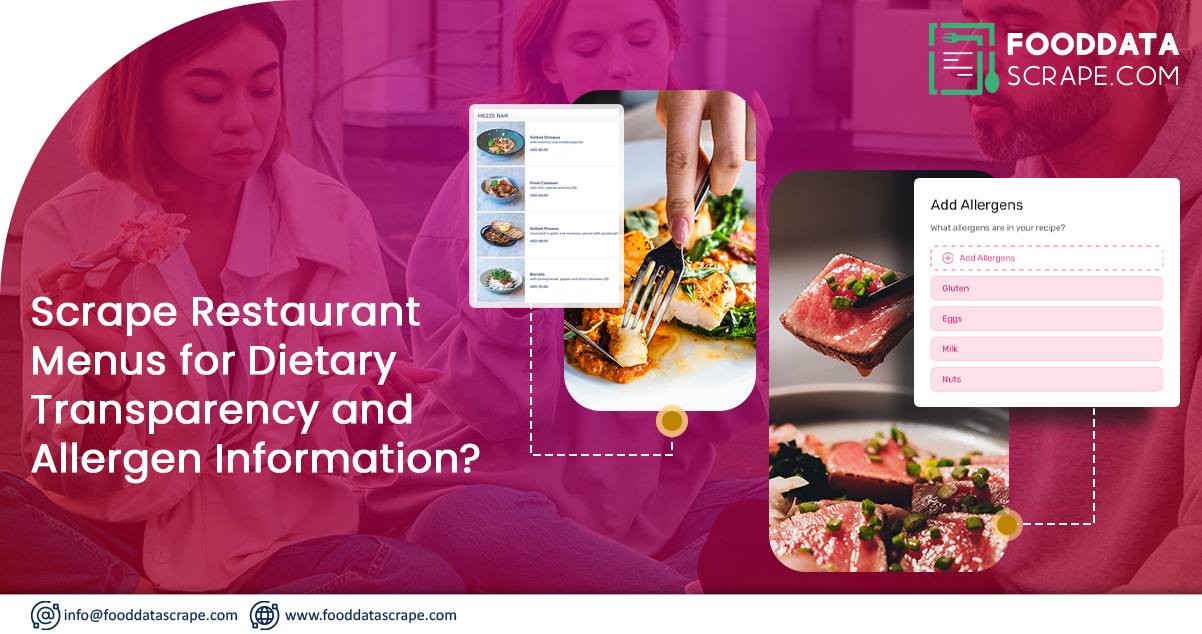In an era where information is at our fingertips, data analytics has extended its reach into unexpected realms, including gastronomy. As pillars of the culinary experience, restaurants often showcase their offerings through menus. While menus are readily available to patrons, the wealth of data embedded within them holds untapped potential for researchers, enthusiasts, and businesses alike. This article delves into the intriguing domain of restaurant menu scraping, exploring its potential benefits, ethical considerations, and the tools available for unlocking culinary insights.
The Allure of Restaurant Menus:
A restaurant menu is more than just a list of dishes; it's a curated narrative of a chef's creativity, a reflection of cultural influences, and a window into the establishment's identity. Menus can reveal culinary trends, ingredient preferences, and even pricing strategies. Analyzing this information can be invaluable for market research, competitor analysis, or simply understanding a particular region's gastronomic landscape.
List of Data Fields
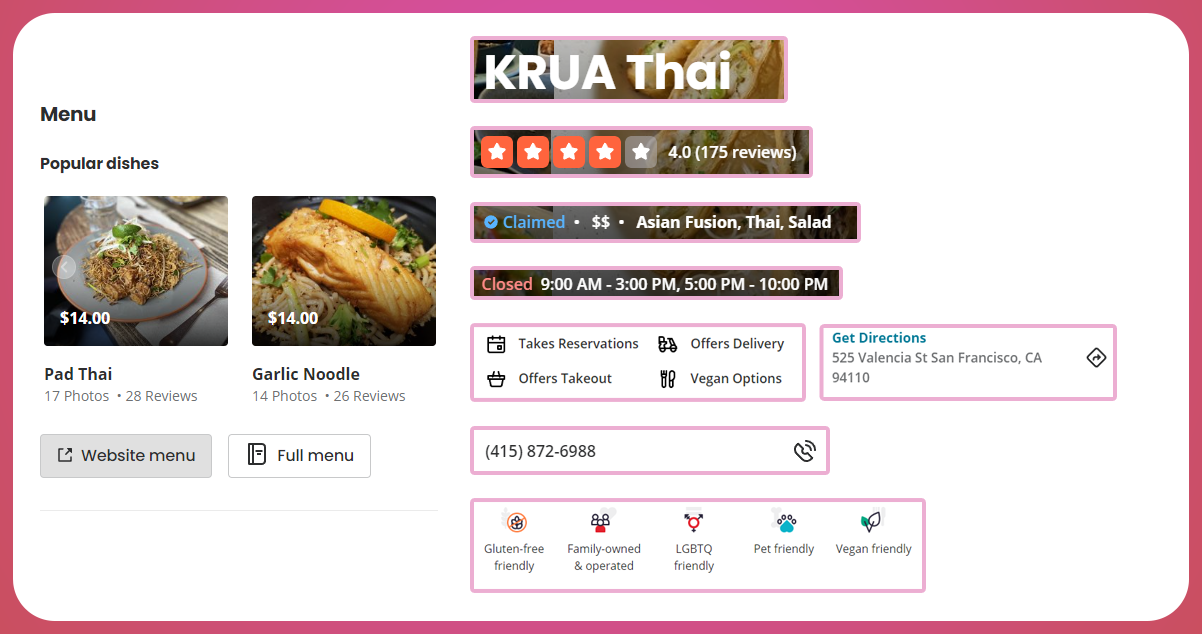
- Dish Name
- Price
- Description
- Category
- Dietary Information
- Allergen Information
- Nutritional Information
- Meal Options
- Availability
- Beverage Menu
- Spice Levels
- Cooking Methods
- Ingredients
- Portion Sizes
The Need for Data:
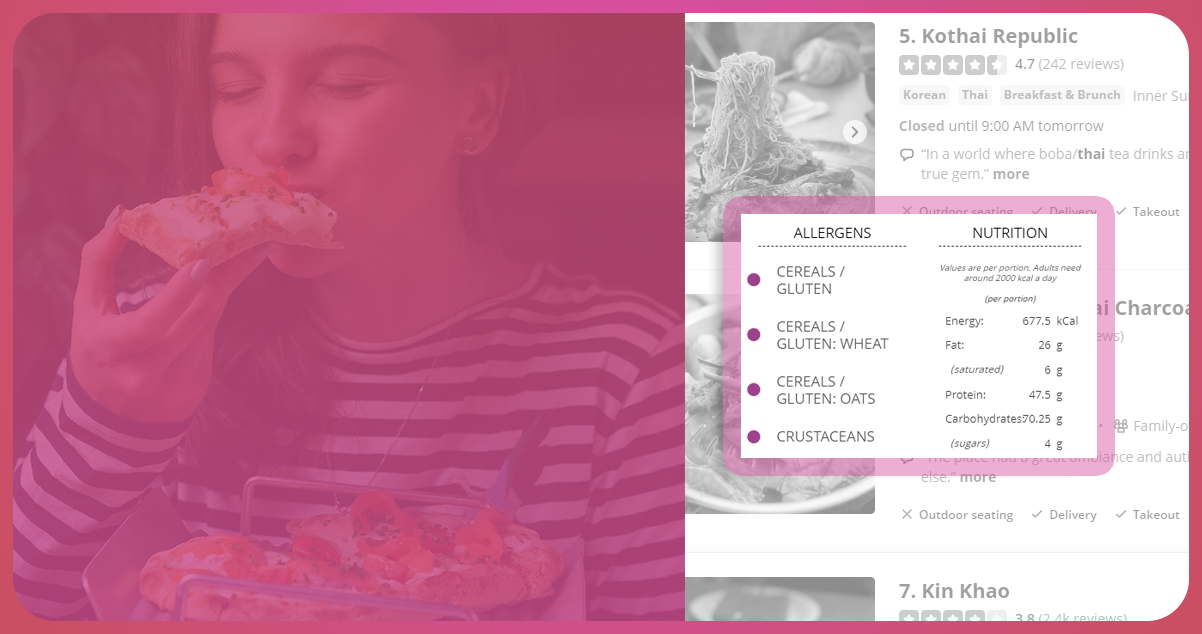
The culinary industry is no exception in a world increasingly driven by data. Restaurants, food critics, and researchers all have a vested interest in harnessing the power of data to make informed decisions, craft compelling narratives, and identify patterns that may go unnoticed in a traditional analysis.
It is where restaurant menu scraping comes into play. By collecting data from digital menus, researchers and businesses can access a treasure trove of information, ranging from popular dishes and pricing trends to ingredient combinations and seasonal variations.
Understanding Restaurant Menu Scraping:
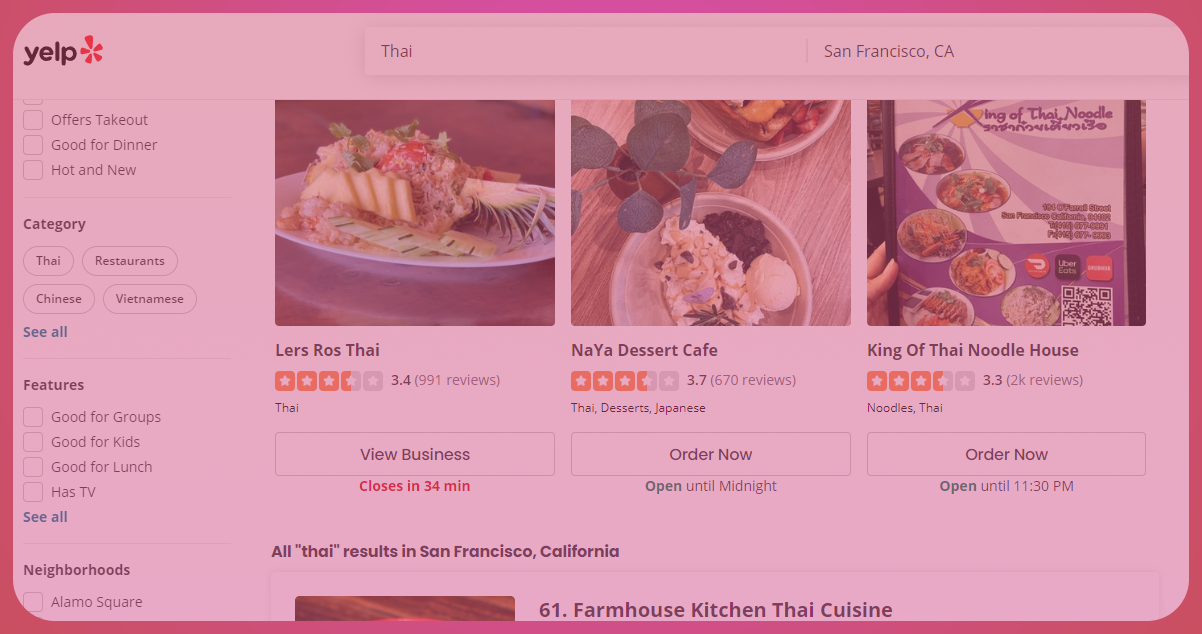
Restaurant menu data scraping involves automated data collection from digital menus available on websites. This process typically utilizes web scraping tools and techniques to collect information such as dish names, descriptions, prices, and categorizations.
While scraping may raise ethical concerns, it's essential to differentiate between ethical and unethical practices. Ethical scraping involves obtaining data with the explicit consent of the website or using publicly available APIs (Application Programming Interfaces) provided by the platform. On the other hand, unethical scraping entails unauthorized access to a website's data, potentially violating its terms of service and legal regulations.
The Benefits of Restaurant Menu Scraping:
Market Research and Trends Analysis: Scrape restaurant menu data from various restaurants to help analysts identify emerging culinary trends, popular ingredients, and evolving consumer preferences. This information is invaluable for businesses seeking to stay competitive and innovative in the ever-evolving food industry.
Competitor Analysis: Restaurants can leverage menu data scraping services to gain insights into their competitors' offerings, pricing strategies, and unique selling points. This information enables them to refine their menus and positioning within the market.
Pricing Strategy Optimization: Restaurant data scraping services allow businesses to analyze pricing trends across different establishments. This information can inform strategic pricing decisions, helping restaurants find the sweet spot that balances profitability and customer satisfaction.
Personalized Marketing: Understanding the preferences of target demographics becomes more accessible with menu data. Businesses can tailor their marketing strategies, including promotions and advertisements, to align with the tastes and preferences of their customer base.
Ethical Considerations:
While the benefits of restaurant menu scraping are evident, it's crucial to approach this practice ethically. Obtaining permission from the website or using publicly available APIs ensures the legal and respectful data extraction process. Additionally, respecting copyright laws and user privacy is paramount to maintaining a positive relationship with consumers and the platforms.
About Yelp
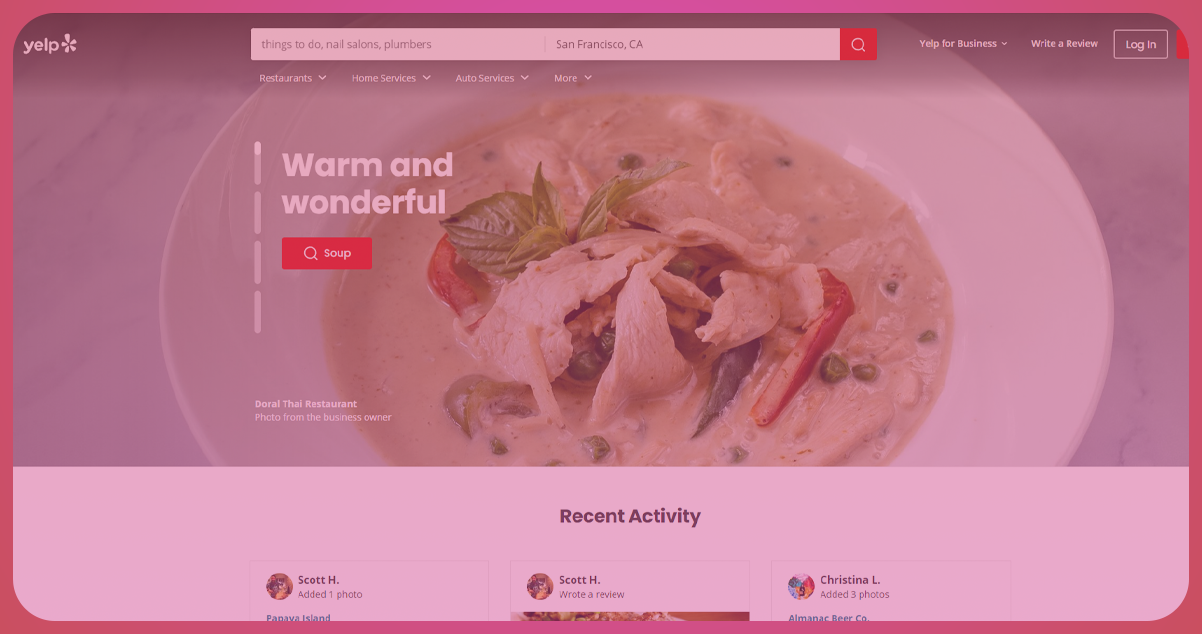
Yelp is a popular online platform that connects users with local businesses by providing reviews, ratings, and information about restaurants, shops, and services. Founded in 2004, Yelp has become a trusted resource for consumers seeking recommendations and insights. Users can share their experiences, rate businesses, and explore reviews to make informed decisions. The platform's extensive database covers various establishments, fostering a community-driven approach to help individuals discover and connect with businesses that best suit their preferences and needs. This article explores the art of scraping Yelp restaurant menu data. This platform connects consumers with local businesses and provides a rich source of culinary information.
The Ethics of Web Scraping:
Before embarking on any scraping endeavor, it's crucial to understand the ethical considerations associated with web scraping. Many websites, including Yelp, have service terms prohibiting automated data extraction. Review and comply with the terms of the scraped website and, if possible, seek explicit permission.
In exploring scraping restaurant menu data from Yelp, we emphasize respecting the website's policies, including copyright laws and user privacy, to maintain a positive relationship with the platform and its users.
Steps Involved in Scraping Restaurant Menu
Here's a general guide on how to scrape restaurant menu data from Yelp using BeautifulSoup in Python:
Install Required Libraries:
Ensure you have BeautifulSoup and requests installed. You can install them using the following:
pip install beautifulsoup4pip install requestsImport Libraries:
In your Python script, import the necessary libraries.from bs4 import BeautifulSoupimport requestsSend HTTP Request:
Use the requests library to send an HTTP GET request to the Yelp page containing the restaurant menu you want to scrape.
url = 'https://www.yelp.com/biz/restaurant-name'response = requests.get(url)Parse HTML Content:
Create a BeautifulSoup object to parse the HTML content retrieved from the Yelp page.
soup = BeautifulSoup(response.text, 'html.parser')Locate Menu Information:
Inspect the HTML structure of the page to identify the HTML tags, classes, or IDs that contain the restaurant menu information. Use BeautifulSoup's methods to extract relevant data.
menu_items = soup.find_all('div', class_='menu-item')Iterate Through Menu Items:
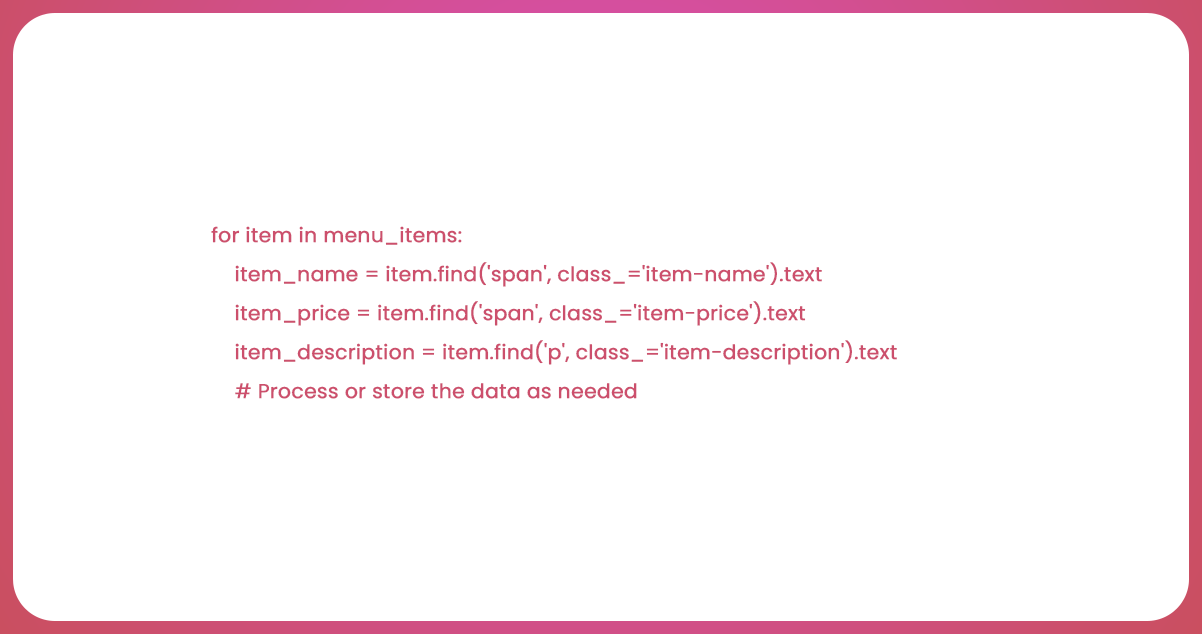
Use a loop to iterate through the extracted menu items and retrieve specific details such as item name, price, and description.
for item in menu_items:
item_name = item.find('span', class_='item-name').text
item_price = item.find('span', class_='item-price').text
item_description = item.find('p', class_='item-description').text
# Process or store the data as neededHandle Pagination (if applicable):
If the menu spans multiple pages, implement code to navigate the pagination and scrape data from each page.
Handle Anti-Scraping Measures:
To avoid detection, consider adding delays between your requests using time.sleep() and mimicking more natural browsing behavior.
Store the Data:

Save the scraped data in a structured format, such as a CSV file or a database, for further analysis or use.
# Example: Save data to a CSV file
import csv
with open('restaurant_menu.csv', 'w', newline='') as csvfile:
fieldnames = ['Item Name', 'Price', 'Description']
writer = csv.DictWriter(csvfile, fieldnames=fieldnames)
writer.writeheader()
for item in menu_items:
writer.writerow({
'Item Name': item.find('span', class_='item-name').text,
'Price': item.find('span', class_='item-price').text,
'Description': item.find('p', class_='item-description').text
})
Run the Script:
Execute your script to perform the scraping. Monitor the script to ensure it runs without errors, and review the scraped data to confirm its accuracy.
Always respect websites' terms of service and use web scraping responsibly and ethically.
Use Cases of Restaurant Menu Scraping
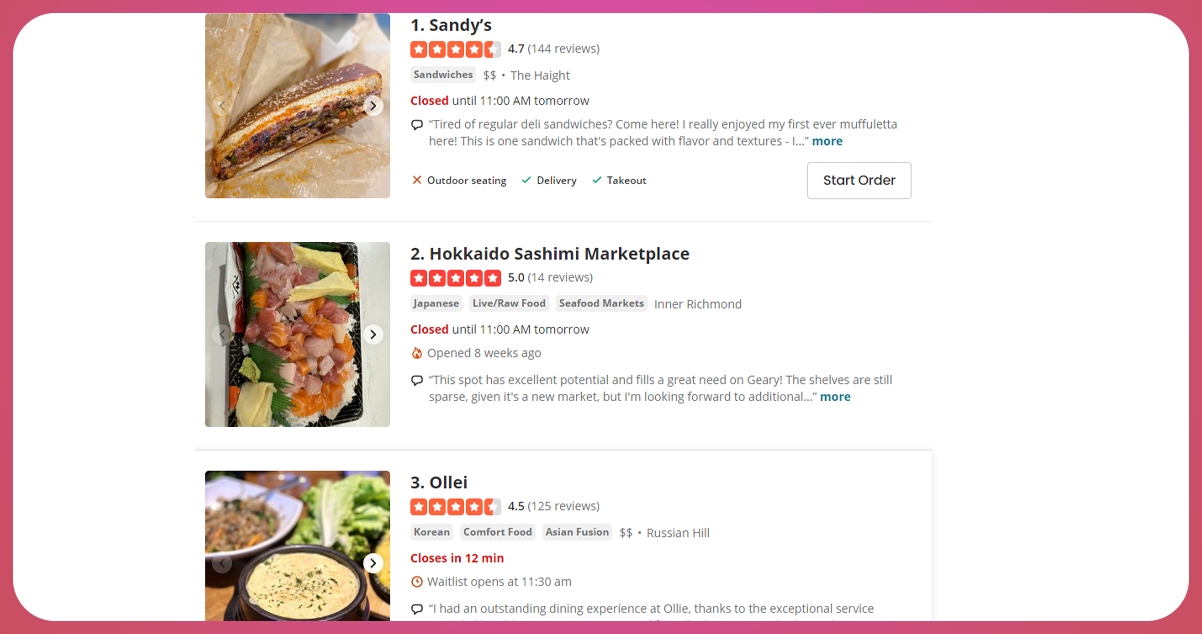
Dynamic Pricing Strategy:
Scraping restaurant menus enables businesses to analyze competitors' pricing structures dynamically. This information is crucial for adjusting pricing strategies based on market demand, competitor prices, and consumer preferences.
Menu Optimization and Innovation:
By scraping data, restaurants can identify popular and underperforming menu items. This insight aids in optimizing existing menus, retiring less popular dishes, and innovating new offerings that align with current market trends.
Dietary Preferences and Allergen Information:
Extracting menu data allows for the analysis of ingredients and nutritional information. This information is valuable for providing accurate allergen details, catering to dietary preferences, and ensuring compliance with regulatory requirements.
Competitor Analysis:
Restaurants can use scraped menu data to conduct in-depth competitor analysis, gaining insights into their rivals' strengths and weaknesses. This information helps businesses differentiate themselves and refine their value propositions.
Customer Personalization:
Understanding customer preferences through menu data scraping facilitates personalized marketing efforts. Restaurants can tailor promotions, loyalty programs, and recommendations based on individual customer preferences, enhancing the overall dining experience.
Supply Chain Optimization:
Analysis of menu data assists in optimizing the supply chain by providing insights into ingredient popularity and demand patterns. This information helps streamline inventory management, reducing waste and ensuring timely restocking of essential items.
Online Platform Integration:
Integrating scraped menu data into online platforms and mobile applications enhances the digital presence of restaurants. It enables seamless online ordering and reservation systems and improves user experiences, fostering customer convenience and operational efficiency for businesses.
For profound insights, connect with Food Data Scrape. We specialize in Food Data Aggregator and Mobile Restaurant App Scraping, offering comprehensive data analytics and insights to enrich your decision-making and elevate your business strategies. Reach out today to unlock a pathway to success guided by data-driven intelligence.






















































































